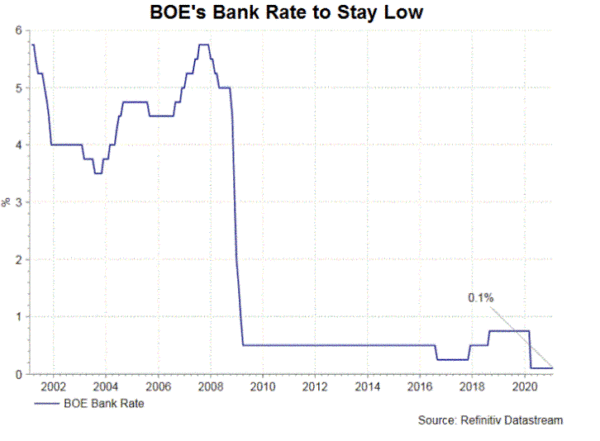At the upcoming BOE meeting, we expect policymakers to vote unanimously to keep the Bank rate unchanged at 0.1%. They would also continue to buy up to 875B pound of UK government bonds and 20B pound of corporate debts. The focus would be on the updated economic projections and hints about QE tapering. We expect to see strong upgrades on the economic outlook, while news on tapering would likely come in August.
Upbeat Dataflow since Last Meeting
Economic data since the last meeting have pointed to resilient recovery momentum. The unemployment rate fell to 4.9% in the three-month period to February, with the weekly data suggesting it dropped to as low as 4.6% during that time. During the period, the number of unemployed was 1.67M, down -50K from the previous three months but up +311K from the same period last year. It is likely that the unemployment rate would shoot higher later this year, mainly driven by the end of the furlough scheme. This could send the unemployment rate to 6-6.5% before ticking down again. On inflation, headline CPI improved to +0.7% y/y in March, from +0.4% a month ago. This came in a tad lower than consensus of +0.8%. As the ONS noted, “the rate of inflation increased with petrol prices rising and clothes recovering from the falls seen in February”. It added that “food prices fell back on the year, as prices of some staples were lower than at the start of the pandemic”. Core CPI picked up to +1.1%, from February’s +0.9%. UK’s economy expanded +0.4% m/m in February, after contracting -2.2% in the prior month.
Leading indicators suggest that the growth momentum would accelerate in the second quarter. IHS Markit /CIPS Flash UK Composite PMI rose to an 89-month high of 60 in April. The final reading in March was 56.4. As suggested in the accompanying report, “companies are reporting a surge in demand for both goods and services as the economy opens up from lockdowns and the encouraging vaccine roll-out adds to a brighter outlook”. It added that “business activity should continue to grow strongly in May and June as virus restrictions are eased further, setting the scene for a bumper second quarter for the economy”. Risks to strong growth include lackluster exports and the sharp rise in price.
Upgrades in Economic Projections
Against this backdrop, the central bank will likely revise higher economic projections from its February estimates. In February, the central bank estimated that the GDP would fall by -4.2% q/q in 1Q21. Yet, economic developments since then have been resilient. Meanwhile, the central bank in March noted that a faster-than-expected pace of easing in restrictions, the Spring Budget and the US fiscal stimulus package were positive developments to the economy. The central bank would likely upgrade this year’s GDP growth forecast to about 6-8% from February’s 5%. Extension of the furlough scheme into September would help the job market, leading to a lower peak of the unemployment rate. The BOE would probably revise the peak rate to just above 6% in 3Q21, compared to 7.8% projected in February.
Monetary Policy Outlook
On the monetary policy outlook, the BOE has been purchasing assets at a pace of 4.4B pound/week. The program would finish by the start of November 2021 if the current pace continues. What the market is interested in is whether the central bank has considered tapering. We expect policymakers to communicate in June, when more information is gathered about the reopening of the economy and developments of the pandemic, that tapering would begin in August. One possibility of tapering is that the central bank would trim the weekly purchase to around 2.5B pound. This could allow the program to run until the end of this year. After all, we expect the BOE would still utilize the entire 875B pound.


 Signal2forex.com - Best Forex robots and signals
Signal2forex.com - Best Forex robots and signals




